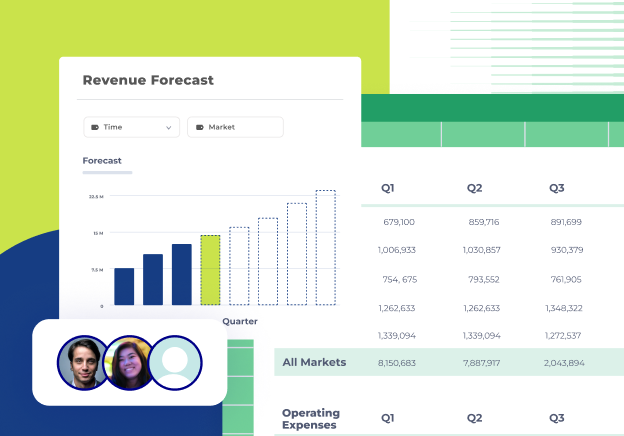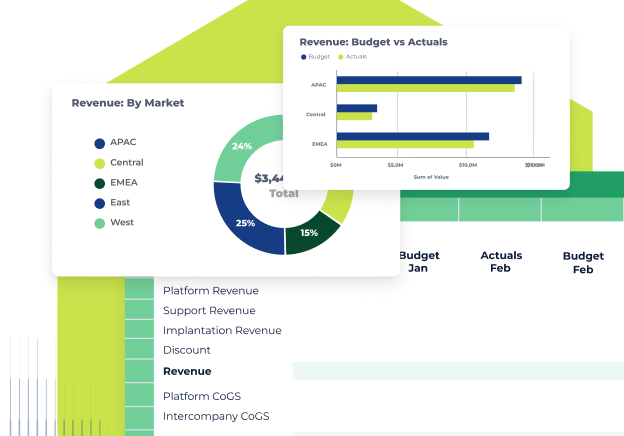What's inside this SaaS revenue model template
Revenue modeling for a subscription business is fundamentally different from traditional models, largely due to the concept of annual recurring revenue (ARR). This SaaS revenue model template includes a detailed ARR table that breaks down growth into four key components:
- New ARR: Revenue from newly acquired customers
- Expansion ARR: Upsells and upgrades from existing customers
- Contraction ARR: Downgrades from existing customers
- Churned ARR: Revenue lost from customer cancellations
It’s important to remember that ARR represents a snapshot in time, while revenue is tracked over a specific period (e.g., a month or quarter). ARR isn’t interchangeable with Generally Accepted Accounting Principles, or (GAAP) revenue—it’s apples and oranges.
To get from ARR to GAAP revenue, we amortize our ARR forecast over anticipated contractual terms, creating a GAAP revenue forecast. For an annual contract, this means dividing the forecasted ARR by 12 months (the life of the contract).
How to use this template with Cube
This is an Excel template. You don't need to be a Cube customer to use it! But if you are a Cube user, you can start using this template in under two minutes.
Step 1: Open the template in Excel or Sheets.
Step 2: Customize the row and column headers to match your Cube's dimensions and filters.
Step 3: Select the range where you want to fetch your data.
Step 4: Fetch your data.
All about SaaS revenue
It’s in the name! SaaS (software-as-a-service) revenue is generated from a subscription pricing model. Many SaaS companies will have products and tiers and then vary their pricing per account based on features, data usage, user licenses, or integrations. It’s also common for companies who have subscription products to generate revenue from non-subscription sources, such as consulting and professional services.
Additionally, leveraging a subscription revenue model not only provides a steady and predictable income stream for SaaS businesses but also helps build long-term relationships with customers. The recurring payments allow companies to scale efficiently while focusing on customer retention and satisfaction.
Terms to know to understand SaaS revenue
ARR: A key metric used by SaaS or subscription businesses to measure the annual run rate of recurring revenue from the current install base. It represents the annual revenue for the next 12 months. Some companies use MRR (monthly recurring revenue), which is the same concept as ARR but expressed monthly.
New ARR: Onboarding new customers during the month drives the increase in ARR.
Expansion ARR: Growth from existing customers during the month drives the increase in ARR. Expansion is due to several factors, including product upgrades, increase in user counts, and price increases.
Contraction ARR: Declines from existing customers who remain customers at the end of the period, but at a lower ARR drive the decrease in ARR. Usually, this is down to users downgrading to a lower-cost tier.
Churn ARR: Lost ARR from churned customers during the month.
What is the SaaS revenue model?
The SaaS revenue model is a software delivery system where customers pay recurring fees at set intervals to access software instead of purchasing a one-time license. SaaS companies typically host the software and all of its data in the cloud and charge users using tiered pricing plans.
As a result, customers always have access to the most updated version of the software—and don’t have to worry about manual updates or expensive upfront costs.
Why is the SaaS revenue model so popular?
The SaaS revenue model is popular because it balances business stability with customer convenience. Recurring revenue from subscriptions ensures financial consistency, which makes budgeting and forecasting easier. This model also offers a lower barrier to entry, so customers don’t need to make a large upfront investment. That affordability means SaaS companies can attract a broader audience—even those who might not have the resources for traditional software purchases.
Frequent updates to the user experience are another important draw. Since the software is hosted and distributed online, SaaS companies can deploy their initial product to customers quickly, and then roll out new features, updates, and fixes regularly without causing disruptions. Using the SaaS revenue model, companies can respond to their customers’ ever-changing needs in real time.
Components of the SaaS revenue model
SaaS pricing models
Choosing the right SaaS pricing model is key to aligning your revenue strategy with customer expectations and profitability goals. These are some of the most popular SaaS pricing models.
Tiered pricing
A tiered pricing model allows companies to offer multiple plans at different price points. Each plan provides a set of features tailored to varying customer needs and budgets. Customers can choose the plan that fits their usage or budget, and then upgrade as theThe SaaS revenue model has specific components that shape how businesses generate and sustain revenue. Consider the following SaaS business model examples as you decide which components are best for your company.
SaaS sales models
SaaS companies typically use one of three sales models, depending on the complexity of the product and the needs of their customers.
Low-touch sales model
When there’s little to no interaction between a sales team and a prospect, this is known as a low-touch sales model. It’s best used for products that are easy for customers to adopt without much assistance. Customers are typically lured in by automated marketing efforts, like email campaigns and free trials. They self-sign up, onboard, and start using the product without needing to speak to a sales rep.
Best for: Companies that target a large audience with straightforward pricing and minimal customization.
High-touch sales model
The high-touch sales model is more personal and hands-on. It’s perfect for complex products or enterprise solutions where trust and tailored support are key to closing deals. Dedicated sales teams work directly with prospects to build relationships and address specific needs. The process often includes live demos, custom solutions, and multiple touchpoints throughout a longer sales cycle.
Best for: High-value contracts that require careful planning, negotiation, and dedicated support.
Hybrid sales model
The hybrid sales model strikes a balance between low-touch and high-touch approaches, giving businesses the flexibility to address a wide range of customer needs. Low-touch methods are used for smaller accounts or self-service products, while high-touch strategies focus on larger, more complex deals. Automation tools can handle repetitive tasks so sales teams can focus on high-value opportunities.
Best for: Companies that serve both small businesses and large enterprises.
ir needs grow.
Flat-rate pricing
With flat-rate pricing, you offer a single product with a single set of features at a single price, regardless of usage or number of users. This straightforward model works best for simple, all-in-one SaaS products aimed at a clearly defined target audience.
Usage-based pricing
Also known as pay-as-you-go pricing, the usage-based pricing model charges customers based on how much they use the product. They pay for metrics like the number of emails sent, API calls made, or gigabytes of data used. It’s ideal for cloud services or tools with unpredictable usage patterns.
Per-user pricing
One of the most popular SaaS pricing models, per-user pricing charges customers based on the number of users or licenses they need. The model works well for collaboration tools and platforms with a user-based structure. It’s simple to calculate and scales directly with the customer’s team size.
Active user pricing
With per-user pricing, new customers might pay for hundreds of seats up-front with no guarantee they’ll actually use them all. Enter active user pricing: This model encourages prospects to sign up as many users as possible, but with the understanding they’ll only be billed for the seats in use by their employees.
Per-feature pricing
Per-feature pricing is one of the more flexible SaaS pricing models. Customers are only charged for the features they access, giving them more control over their spending. This model is great for products with modular functionality, where users have a variety of different needs.
Transaction-fee pricing
The transaction-fee pricing model is exactly how it sounds—customers pay a fee for each transaction processed through the platform. Fees are either a percentage of the transaction or a flat rate. This model is commonly used in e-commerce or payment processing platforms.
Freemium pricing
Freemium pricing provides a basic version of the software for free, with the option to upgrade for advanced features. Free tiers are limited in scope in order to entice users to upgrade—usually, by hiding certain features behind a paywall or limiting daily usage until you subscribe to a paid package. It’s a low-stakes way to attract users and helps build brand awareness.
Avoiding mistakes in SaaS revenue modeling
Avoiding these common missteps ensures that your SaaS revenue model template remains a reliable compass that steers your business toward sustained growth.
Ignoring variable costs
Overlooking variable costs, such as customer acquisition expenses or server costs, can result in inaccurate financial projections. Ensure all aspects of your expenditures are accounted for in your template.
For example, how much does each customer acquisition cost versus what they’ll pay you? How much cloud storage will be required to accommodate an increase in customers and/or an increase in customer usage?
Underestimating churn rates
Revenue churn—the percentage of customers who cancel their subscriptions—is one of the most important SaaS KPIs to keep tabs on. A miscalculation in churn rates can throw off your revenue forecasts. Be realistic and factor in potential customer attrition to maintain a more accurate projection of your subscription-based revenue.
Overlooking seasonal trends
Seasonality refers to predictable patterns in data that tend to repeat at specific times every year. Forgetting to incorporate seasonal trends can lead to skewed predictions. Analyze historical data and adjust your template to accommodate any recurring patterns in your SaaS revenue. (Our free SaaS revenue model template makes it easier to compare periods, spot seasonal patterns, and boost the accuracy of your financial forecasting models.)
Disregarding customer segmentation
Treating all customers alike in your template might mask valuable insights. It can also dilute user experience and impact customer retention. Implement customer segmentation to tailor your revenue model, considering different subscription tiers, pricing plans, and customer demographics.
Additional resources
Grab your free SaaS revenue model template for Excel
Our downloadable SaaS revenue model template is designed to help you simplify revenue analysis and forecasting. Enter your business email and download the template to get started immediately.


.png)









.png)
